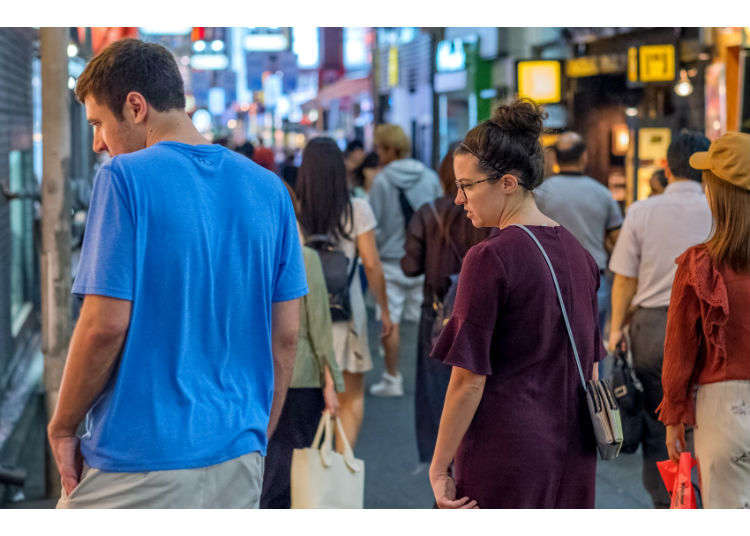
Ultimate Tokyo 2-Day Itinerary: What to Do With 48 Hours in Tokyo
- Written by: Matt Vachon
So you have found yourself in Tokyo with a minimal amount of time to spend. Maybe you’re here on an extended layover while passing through to another destination. Perhaps Tokyo is just one small part of your vacation to Japan. Regardless of the reason, one fact remains clear - you have stepped off the plane, and the clock is ticking.
Tackling Tokyo in just two days is no small feat; it’s one of the biggest cities in the world, after all. Follow the winding streets through its wildly varying neighborhoods, and you will quickly realize how easy it is to become overwhelmed here.
In order to make the best use of your time, a well-thought-out itinerary is a must. For those seeking the “quintessential Tokyo experience,” look no further.
What to do in 2 Days in Tokyo
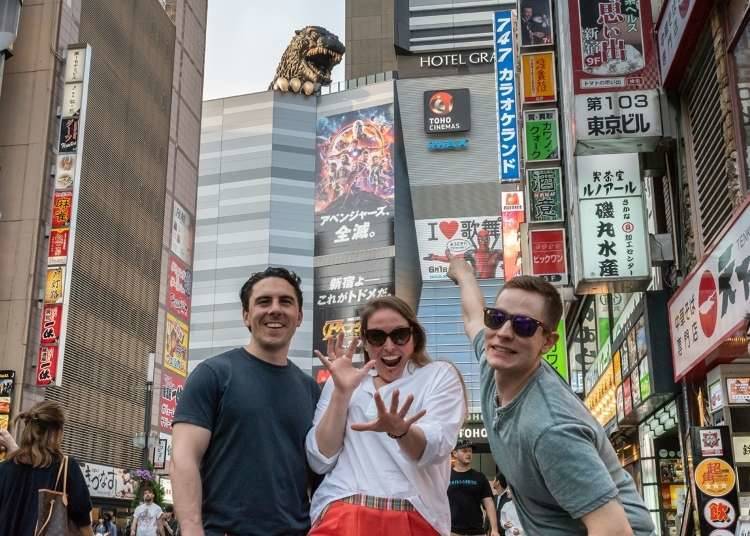
While you will undoubtedly want to see and do as much as possible over the next two days, it’s important not to rush through everything and skimp on the overall experience.
Therefore, the following guide has been laid out in a way that if followed in order, will maximize the amount of places you can see while still allowing time to enjoy the moment at your own pace.
Day One in Tokyo
1. Shinjuku Gyoen - 9:00 AM
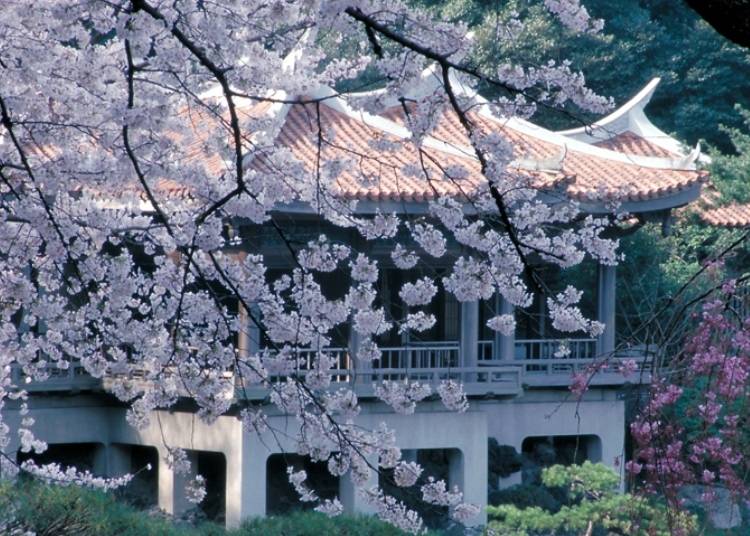
What better way to begin your Tokyo adventure than by getting into a zen-like state of mind with a walk through an authentic Japanese garden? Despite its location in the heart of the city, Shinjuku Gyoen’s massive public green space feels far removed from the non-stop pace of its urban surroundings.
This is a great first stop on your 48 hour Tokyo adventure as it opens earlier than most local attractions and provides a glimpse into a quieter, more traditional side of Japan without leaving the city.
The park opens at 9:00 AM, so I recommend leaving your hotel by 8:30 and coming here early to enjoy the morning serenity and start your day with a traditional cup of matcha at one of the park’s two teahouses.
Hours: 09:00 - 16:00 Tuesday through Sunday. The park is closed on Mondays.
Price: Admission to the park is \200.
How Much Time to Spend Here: Assuming you arrive at 9:00 AM for the opening, aim to spend 1.5 hours in the park - 15-30 minutes for tea and 1 hour for walking through the gardens and enjoying the scenery. As Tokyo is a city that tends to get started on the later side, you can take your time here before heading off to your next destination.
-

-
Address
11 Naito-cho, Shinjuku-ku, Tokyo, 160-0014
View Map -
Nearest Station
Shinjuku-Gyoemmae Station (Tokyo Metro Marunouchi Line)
5 minutes on foot
- Phone Number 03-3350-0151
-
Address
11 Naito-cho, Shinjuku-ku, Tokyo, 160-0014
2. Akihabara - 11:00 AM
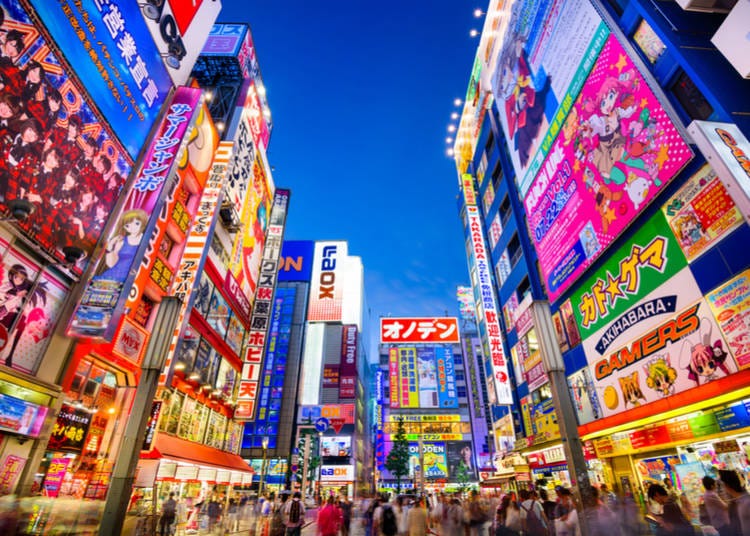
As the global hub of otaku culture, there is an inexplicable sense of wonder about Akihabara shared by self-proclaimed manga nerds and curious outside observers alike. Whether or not you find the prospect of hunting for scale replicas of your favorite anime character thrilling, the fact remains that Akihabara truly has something for everyone.
If you are following this guide, you should arrive in Akihabara around 11:00 AM. This is a great window of time, as most stores will be open by this point, but it is still early enough to beat the majority of the crowd.
Start your experience at one of the many arcades scattered throughout the neighborhood. Challenge your friends to the seemingly endless array of games, or if you’re on your own, try your hand at winning a plushy new friend from one of the many UFO Catcher machines.
Afterward, grab some tapioca tea (the Japanese term for bubble tea) at a nearby maid cafe. These iconic cafes have become a staple in otaku culture and are often recognizable to fans of anime and Japanese media worldwide.
Not sure where to find one? Don’t worry. It will find you. Walk for more than 30 seconds in Akihabara, and you are bound to come across girls in maid cosplays encouraging you to visit their cafe.
Lastly, no trip to Akihabara is complete without a little souvenir shopping. Affectionately dubbed “the world’s largest electronics district,” if you can’t find what you’re looking for amongst the dense sea of back-alley shops, it very well may not exist. There is a store for just about everything you can imagine here, from appliances, action figures, to vintage video games and beyond. Shop around for the perfect Tokyo souvenir, but set a time limit. It’s easy to lose track of time and spend an entire day browsing these stores.
How to Get Here From Shinjuku Gyoen: From Shinjuku-Sanchome station, take the Marunouchi line towards Ikebukuro to Yotsuya. From here, change to the Chuo-Sobu line towards Tsudanuma and get off at Akihabara station.
Travel Time: Approximately 30 minutes.
How Much Time to Spend Here: It’s easy to get overwhelmed here with how much there is to see and do, but aim to keep your visit under two hours. This should still leave you plenty of time to play a few arcade games, browse some shops, grab a snack, and be on your way to your next destination by 1:00 PM.
-

-
Address
Sotokanda, Chiyoda-ku, Tokyo Chuo-dori, 101-0021
View Map -
Nearest Station
Akihabara Station (JR Keihin-Tohoku Line / JR Yamanote Line / Tokyo Metro Hibiya Line / Tsukuba Express / JR Sobu Line)
- Phone Number 03-3257-0568
-
Address
Sotokanda, Chiyoda-ku, Tokyo Chuo-dori, 101-0021
3. Visit Senso-ji Temple - Around 1:30 PM

While it’s not uncommon to think of Tokyo only in regards to its modern aspects, it’s important to note that this city contains a great deal of history as well. One of Tokyo's most visited historical spots is Senso-ji Temple in Asakusa.
Built in 645 A.D., it is the oldest temple in the city. Famous for its large red lantern (chochin in Japanese), five-storied pagoda, and shopping stalls on Nakamise Street; Senso-ji is a rite of passage for any Tokyo visitor.
There’s not necessarily a “good time” to get here; it’s almost always crowded, but getting here around lunchtime is in your best interest. With all the shops and food vendors on Nakamise Street, you’ll be able to try a sampling of classic Japanese street foods such as yakisoba, takoyaki, and okonomiyaki. If you’re in the mood for a more substantial sit-down lunch, there are plenty of nearby restaurants to choose from.
Asakusa is highly regarded for its soba noodles, which can be found at many local shops.
Once you’ve eaten, it’s time to head into the temple. For the authentic experience, first, stop by the large incense burner outside and fan some of the smoke onto yourself. Incense smoke is believed to have healing powers, so people typically cleanse themselves with it before entering.
Next, visit the purification fountain just outside the entrance. There will be several large ladles laid out for you to use. Fill a ladle with water and rinse one hand, then the other. Depending on how strictly you want to adhere to traditional customs, the final step of the purification is to rinse your mouth with the water. However, with Covid-19, currently, this area is often not possible to use.
Upon entering the temple, you will find a large box with a slotted wooden top. This is a saisen, or offering box. Toss a coin into the box, press your hands together in front of your chest and pray quietly. Then bow once after you are done praying; you’ve officially completed your traditional Japanese temple visit!
That process can be a bit confusing the first couple of times you do it, and understandably so. Just keep an eye on the people around you and do what they’re doing, and you’ll be fine.
Afterward, explore the surrounding area for some souvenir shopping. There are many unique gifts to be found along Nakamise street. Be sure to stop and grab a drink at a nearby standing bar as well; a classic Japanese experience.
How to Get Here from Akihabara: From Akihabara Station, take the Ginza line and get off at Asakusa station.
Travel Time: Approximately 20 minutes.
How Much Time to Spend Here: Given the regular crowds, Senso-ji is not an area that can be seen quickly. If stopping for lunch, shopping, etc. as well, plan to spend 3 to 4 hours here. However, don’t feel the need to rush. There is a great deal of culture in this area, and it should be thoroughly enjoyed.
-

-
Address
2-3-1, Asakusa, Taitou-ku, Tokyo, 111-0032
View Map -
Nearest Station
Asakusa Station (Tokyo Metro Ginza Line / Toei Asakusa Line / Tobu Isesaki Line (Tobu Skytree Line) / Tsukuba Express)
5 minutes on foot
- Phone Number 03-3842-0181
-
Address
2-3-1, Asakusa, Taitou-ku, Tokyo, 111-0032
4. Tokyo Metropolitan Government Building - Around 6:00 PM
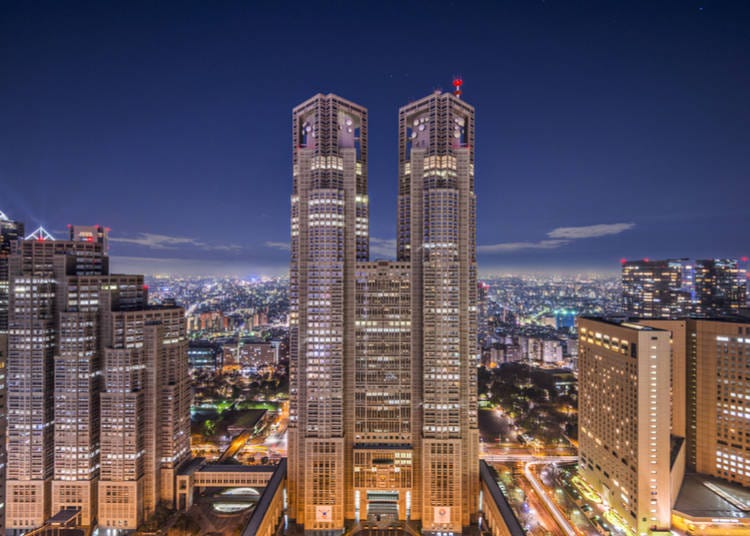
As the sun starts to set, make your way back to Shinjuku for an unbeatable view of the city. At the top of the Tokyo Metropolitan Government Building, there is a 360° observatory deck.
While the observation deck at the top of Tokyo SkyTree may give you a view from higher up, the Tokyo Metropolitan Government Building is completely free, and the view is comparable. Be sure to check online for what time the sun will set that day, as it is a view you will not want to miss.
There are separate north and south towers, both of which house observatory decks, but the south deck closes at 5:30 P.M. If you are here to watch the sunset, head to the north tower, which is open until 11:00 P.M.
Try to arrive a little while before the sun goes down, as, on clear days, you can even spot Mount Fuji in the distance. If you are so inclined, there is also a cocktail bar in the north observatory deck where you can enjoy drinks while overlooking one of the best views of the city.
How to Get Here From Senso-ji Temple: From Asakusa Station, take the Ginza line to Akasaka-Mitsuke Station. From here, change to the Marunouchi line towards Ogikubo and get off at Nishi-Shinjuku Station.
Travel Time: Approximately 50 minutes.
How Much Time to Spend Here: Feel free to take your time here, marveling over the view and taking photos. However, if you are eager to get back out and explore, visiting the observatory should take no more than 30 minutes to 1 hour, depending on if there is a line for the elevator.
-

-
Address
2-8-1, Nishishinjuku, Shinjuku-ku, Tokyo, 163-8001
View Map -
Nearest Station
Tochomae Station (Toei Oedo Line)
- Phone Number 03-3277-2815
-
Address
2-8-1, Nishishinjuku, Shinjuku-ku, Tokyo, 163-8001
5. Explore Shinjuku’s Kabukicho Area - Around 7:00 PM
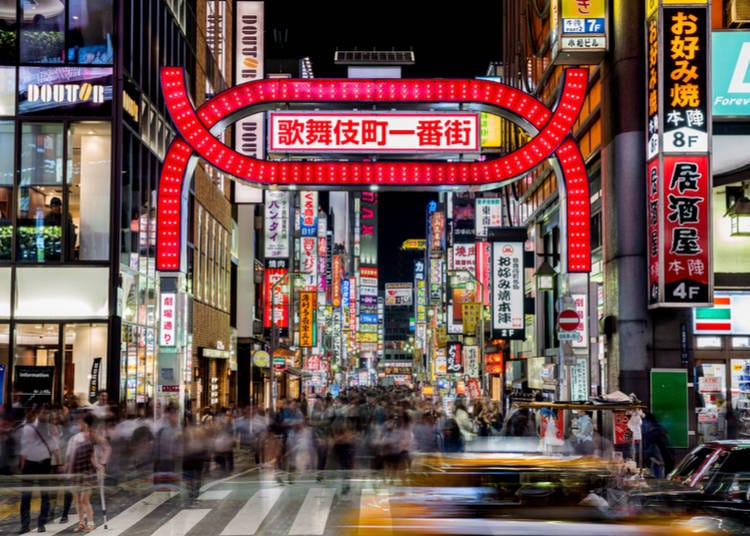
While not exactly the most family-friendly neighborhood in Tokyo, Kabukicho is certainly one of the most iconic.
Its streets, densely packed with foot traffic and neon signs as far as the eye can see, is a familiar sight to anyone who has ever searched for pictures of the city online. The area is active all day, but it is best visited at night for the full visual effect.
Though it is largely known as Tokyo’s red-light district, the area is also home to an impressive amount of bars, restaurants, shopping, arcades, and more. At the center of Kabukicho is the Toho movie theater, atop which you will find the massive, looming head of the legendary Godzilla. If for nothing else other than this, come to Kabukicho to snap the perfect Tokyo vacation photo.
When you’re ready to eat, you’ll find there is no shortage of establishments to choose from. Two popular options with the late-night crowds of Tokyo are yakitori and kushiage. Yakitori translates to “grilled chicken,” and it is typically ordered by the skewer.
Nearby, you'll also find kushiage restaurants that serve a variety of fried foods on a stick. For instance, at Kushiya Monogatari, you’ll find everything from vegetables, to cheeses, to fish fried up to crispy perfection and served on a skewer. These are fantastic options to prepare yourself for our next stop. Itadakimasu!
How to Get Here From The Tokyo Metropolitan Government Building: From Tochomae station, take the Oedo line to Shinjuku-Nishiguchi station. Alternatively, the walk to Kabukicho only takes roughly 15 minutes.
Travel Time: Approximately 10-15 minutes.
How Much Time to Spend Here: Between eating, shopping, and taking photos, plan to spend around 3 hours in Kabukicho.
-

-
Address
Kabukicho, Shinjuku-ku, Tokyo, 160-0021
View Map -
Nearest Station
Shinjuku Station (JR Shonan Shinjuku Line / JR Yamanote Line / JR Chuo Main Line / JR Saikyo Line / Tokyo Metro Marunouchi Line / Toei Shinjuku Line / Toei Oedo Line / Keio Line / Keio New Line / Odakyu Odawara Line)
-
Address
Kabukicho, Shinjuku-ku, Tokyo, 160-0021
6. Bar Hop in Shinjuku’s Golden Gai - 10:00 PM
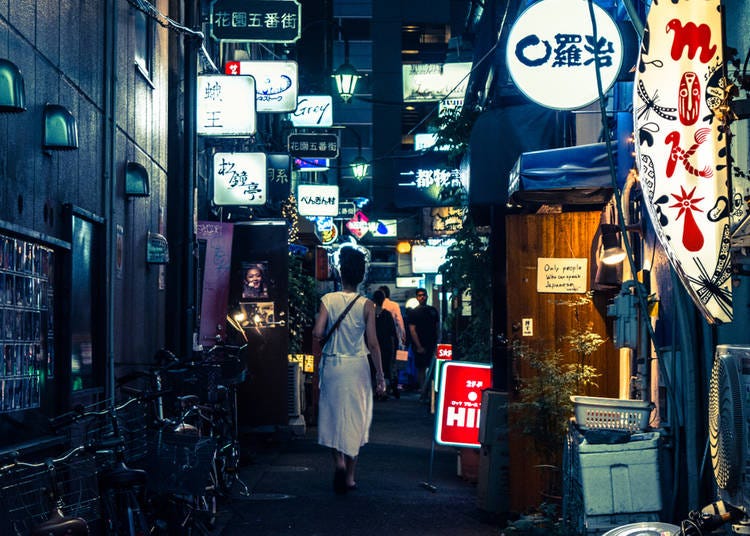
Spend a little time exploring the Tokyo nightlife, and you will quickly come to find that drinking is a big part of Japanese late-night culture. Perhaps there is no better a way to mingle with the locals than by bar-hopping in Golden Gai, a winding maze of eclectic little bars. Behind every doorway is a unique experience. One moment you’re in a tiny dive bar with vinyl records plastered on the walls. The next, you are tucked away in an attic crawl space lit by Christmas lights, cocktail in hand.
What really adds to the charm of this place is that most bars contain no more than ten seats at most, so it’s almost impossible not to interact with other patrons. Alcohol plus close quarters equals great new friends in the Tokyo bar scene. However, keep an eye on signs posted outside the bars, as some will have a cover or minimum drink charge to keep seats from being taken by those just there for the scenery.
How to Get Here From Kabukicho: Golden Gai is right next door, just a five-minute walk away.
How Much Time to Spend Here: That is completely up to you! Bars in Tokyo are open till the sun comes up (and sometimes a bit beyond that as well), so feel free to spend as much time bar-hopping as you like. That being said, there is a big day ahead tomorrow, so you might want to get some sleep.
Day Two in Tokyo
1. Tsukiji Outer Market
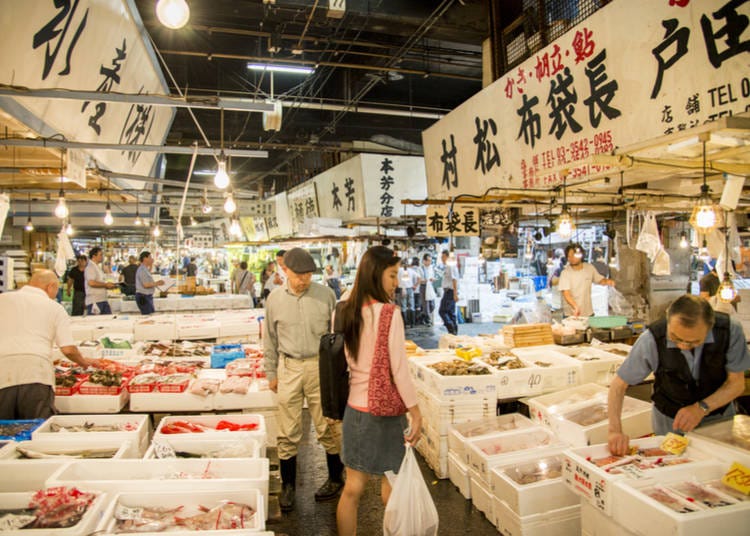
The name may not immediately jump out at you, but the Tsukiji Outer Market is a legendary Tokyo locale that should not be missed by any visitor.
While the Tsukiji Fish Market functions were transferred to the current Toyosu Market, there is still lots to see and do in this area. The Outer Market is home to many restaurants that serve up some of the city's freshest seafood at bargain prices.
For those looking to eat like the locals, many restaurants open early for you to indulge in a sushi breakfast. One spot, in particular, Sushizanmai, is well-known for being Japan’s first 24-hour sushi restaurant.
How Much Time to Spend Here: Plan to arrive by 8:00 AM and spend around 2 to 3 hours if eating breakfast here. Those interested in street photography may want to spend a bit more time at Tsukiji capturing the early morning action.
-

-
Address
Amount of 1,000 ridge 1F, 4-16-2, Tsukiji, Chuo-ku, Tokyo, 104-0045
View Map -
Nearest Station
Tsukijishijo Station (Toei Oedo Line)
1 minute on foot
- Phone Number 03-3541-9444
-
Address
Amount of 1,000 ridge 1F, 4-16-2, Tsukiji, Chuo-ku, Tokyo, 104-0045
2. Relax at Odaiba
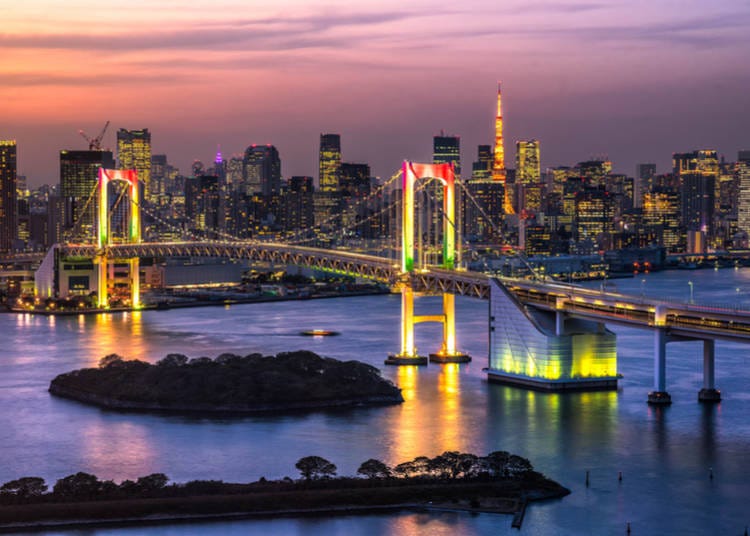
Assuming you started your morning early at the fish market, a leisurely waterfront afternoon will be the perfect thing to ease you into the rest of the day. Located in Tokyo Bay, Odaiba is an artificial island quickly becoming one of Tokyo’s most popular tourist hotspots.
With its wide variety of shopping, restaurants and city views, it’s not hard to understand why. It’s best to visit Odaiba in the early afternoon before the large shopping crowds take over. After visiting Tsukiji, you should arrive in Odaiba around 10:00 or 11:00 AM and enjoy lunch at any of the area's shopping centers.
How to Get Here from Tsukiji Fish Market: From Tsukijishijo station, take the Oedo line towards Roppongi and get off at Shiodome station. Change to the Yurikamome line towards Toyosu and get off at Daiba station.
Travel Time: Approximately 35 minutes.
How Much Time to Spend Here: On average, you can plan to spend roughly 3 hours in Odaiba shopping and eating. If you would like to visit the onsen as well, add on at least another 2 hours.
3. Visit Meiji Shrine
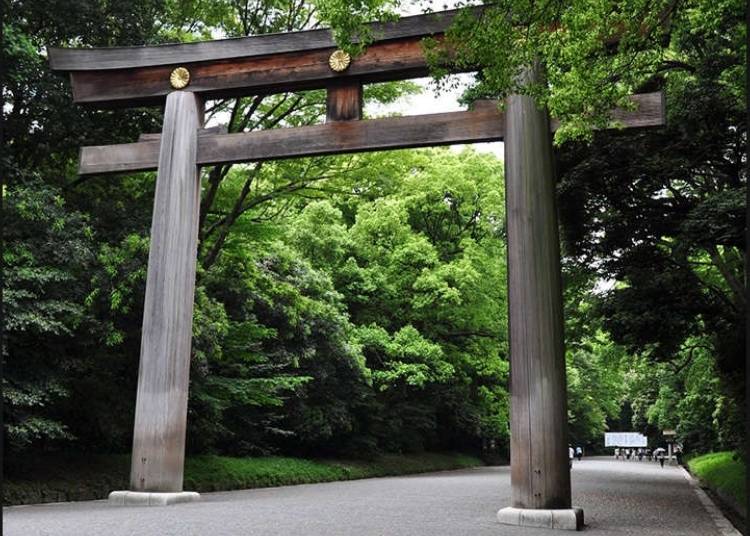
No trip to Tokyo is complete without a trip to Meiji Shrine. Not only is it Tokyo’s most popular shrine, but at 170 acres, it is easily the largest as well. Located in a forested area containing over 120,000 trees, Meiji Shrine is a beautiful green space escape from the neighboring area of Shibuya. While exploring the grounds, be sure to take a moment to appreciate the wall of hand-painted sake barrels, all of which were donated by various sake brewers around Japan as an offering to the shrine’s deities.
Much like at Senso-ji, you will find a purification fountain and offering box in the shrine.
However, praying at a shrine is slightly different from at a temple. At Meiji Shrine, you would still throw a coin in the offering box. Then bow twice, deeply. After bowing, clap your hands twice. Should you want to pray, do so after clapping. When you are done, bow once again, just as deeply as before.
Depending on the time of year you are visiting, you also have the chance to witness part of a traditional Japanese wedding ceremony. Meiji Shrine is one of the most popular wedding spots in the country, so they are fairly common. Feel free to take pictures, but please be respectful and pay attention to the guards who will guide traffic not to disrupt the ceremony.
The shrine is open from sunrise to sunset every day, so late afternoon/early evening is the perfect time to visit. The natural golden hour lighting will add a beautiful ambiance to your vacation photos.
How to Get Here From Odaiba:
From Tokyo Teleport station, take the Rinkai line to Osaki station. There, take the Yamanote line towards Shibuya and get off at Yoyogi station.
Travel Time: Approximately 45 minutes.
How Much Time to Spend Here: If you are visiting only the main grounds of Meiji Shrine, 1 hour should be enough time to explore. If you would like to see the additional gardens on site as well, add another 30 minutes to 1 hour.
-

-
Address
1-1, Yoyogikamizonocho, Shibuya-ku, Tokyo, 151-8557
View Map -
Nearest Station
Sangubashi Station (Odakyu Odawara Line)
- Phone Number 03-3379-5511
-
Address
1-1, Yoyogikamizonocho, Shibuya-ku, Tokyo, 151-8557
4. Walk Takeshita Street
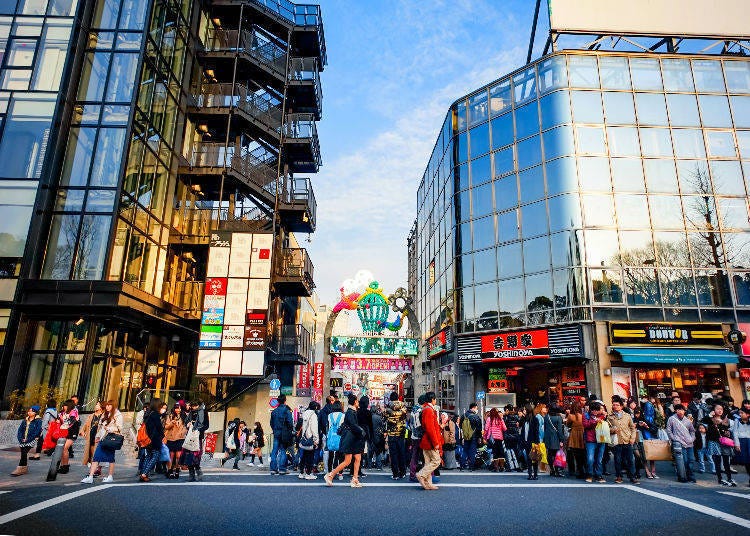
Long known for being the birthplace of kawaii culture in Japan, Harajuku also stands as the hub of avant-garde youth fashion. Along its famous Takeshita Street, you’ll see clothes ranging from cute, to cutting-edge, to downright bizarre.
On weekends, it’s not uncommon to see groups of cosplayers out sporting the latest ahead-of-the-times styles. Takeshita street is typically packed with curious onlookers, but the benefit of being stuck in a slow-moving crowd is that it gives you plenty of time to window shop and take photos. Takeshita Street is generally busy throughout the day, but arriving in the early evening will help to keep you a little cooler in the crowds of people.
How to Get There From Meiji Shrine: Takeshita Street is just across the street from the entrance to Meiji Shrine. Follow the crowds, and it should lead you there.
How Much Time to Spend Here: Even with the throngs of visitors, it does not take long to see Takeshita Street. For simply walking through and people watching, 20 minutes should suffice. If you would like to visit some stores, plan to take 1 to 1.5 hours here.
5. Cross the Shibuya Scramble
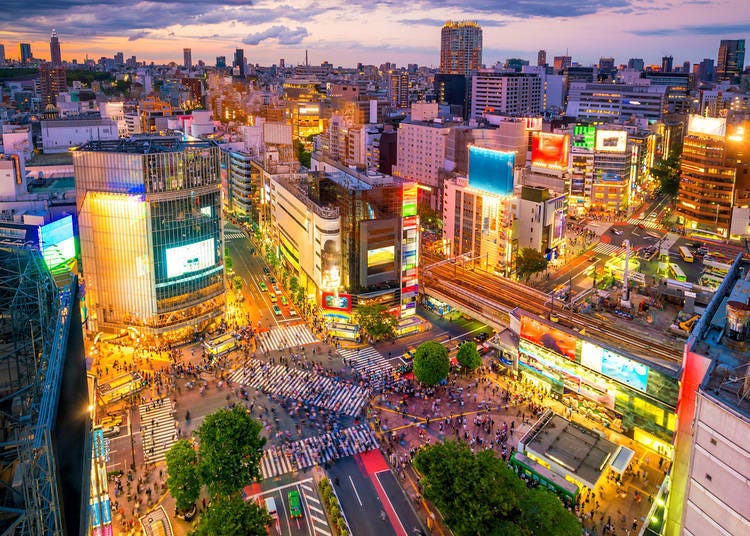
Known as the busiest intersection in the world, Shibuya Crossing more than lives up to its reputation once the sun goes down. Located just outside of the Shibuya Station Hachiko exit, approximately 2,500 pedestrians walk across this intersection with each change of the traffic lights. This repeated mass migration has earned it the nickname of the Shibuya Scramble. To experience the full effect of the scramble, visit in the evening, when the crowds are at their biggest.
Before joining the sea of people, stop by the statue of Hachiko, a Japanese Akita dog that became famous for his loyalty to his owner, for luck. Once you’re ready, pick a direction, wait for the crosswalk sign to change, and cement your place in a world record statistic.
Afterward, head upstairs to one of the several cafes located in the crossing and enjoy people watching from above. For the best view of the scramble, check out Magnet by Shibuya 109. There is a 500 yen admission fee, but the spectacular view is well worth the price.
How to Get There From Takeshita Street: From Takeshita Street, take the Yamanote line to Shibuya station. Alternatively, after walking through Takeshita Street from the Meiji shrine side entrance, turn right and walk roughly 15 minutes.
Travel Time: Approximately 10-15 minutes.
How Much Time to Spend Here: As the last stop on your 48 hour Tokyo itinerary, take all the time here you would like! It is not uncommon to see tourists crossing the scramble many times to capture the perfect travel photo. Feel free to do the same. You’ll be in good company.
-

-
Address
Dogenzaka, Shibuya-ku, Tokyo bottom, 150-0043
View Map -
Nearest Station
Shibuya Station (JR Shonan Shinjuku Line / JR Yamanote Line / JR Saikyo Line / Tokyo Metro Ginza Line / Tokyo Metro Hanzomon Line / Tokyo Metro Fukutoshin Line / Tokyu Toyoko Line / Tokyu Den-en-toshi Line / Keio Inokashira Line)
1 minute on foot
-
Address
Dogenzaka, Shibuya-ku, Tokyo bottom, 150-0043
Once the Tokyo sightseeing has come to a close, there is perhaps no better finale than to dine at an authentic izakaya; an informal Japanese version of a pub. A favorite after-hours stop for droves of Japanese working professionals, izakayas are a great way to unwind after a long day and socialize with the locals over cold drinks and delicious small plate dishes. With a drink in hand, join your neighbors for a hearty “kanpai” to celebrate the end of your Tokyo adventure.
How to get to Tokyo from Narita and Haneda Airports
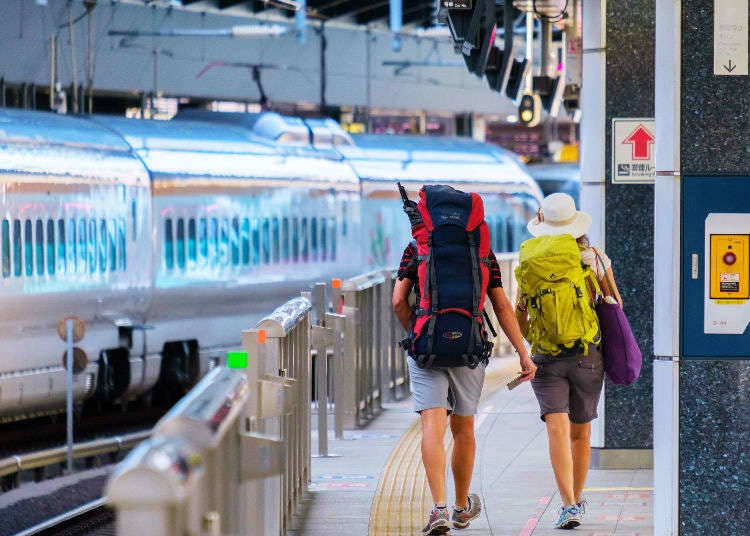
If you have flown into Tokyo from somewhere outside of Japan, you will most likely find yourself in Narita or Haneda airport. There are many options available to ferry you into the city, but the biggest factors to consider are time and money. Whether it’s more important to you to reach the city as quick as possible or within a tight budget, your best options are as follows.
From Narita
Fast: One of the fastest way to get to Tokyo from Narita is via the Narita Express. This express train can get you from the airport to the city in just over an hour for as little as 3,020 yen (about $27 USD). The train stops at several major hubs including Tokyo Station, Shibuya, and Shinjuku; from which you can easily access all points of the city. You can also buy discounted round trip tickets online starting at 4,000 yen for adults and 2,000 yen for children. The express train departs from Narita for Tokyo roughly every 30 minutes.
Cheap: As a less expensive alternative to the Narita Express, take the JR Sobu Line. Though the trip takes slightly longer at approximately 90 minutes one way, it is less than half the price of the express train; costing 1,320 yen. The Sobu Line departs from Narita for Tokyo Station once every hour.
From Haneda
Fast AND Cheap: Coming from Haneda, your best bet in the interest of time and money is the Keikyu Airport Line. Take this train to Shinagawa Station, at which point you can transfer to the Yamanote Line to reach your destination in the city. Based on where you are going, the trip takes about 30-40 minutes and costs roughly 600 yen (about $5.50 USD).
Easy: For those who don’t want to bother with changing trains, there is the Limousine Bus. The buses depart from the airport every half hour, with routes servicing many of Tokyo’s major areas. The ticket prices vary based on where you are going, but you can expect to pay between 1,000-1,500 yen. While certainly more convenient, you will have to contend with the added variable of traffic. Depending on the time of day you are traveling, your one hour drive time could easily double.

Where to Stay
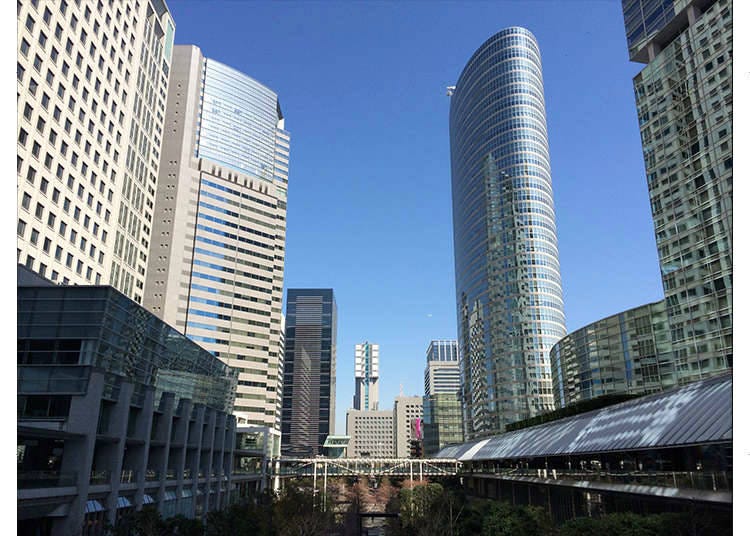
When it comes to deciding on an area to stay in, people are often tempted to choose a location right next to one or two of the major tourist attractions. However, your time could be better spent by choosing a place centrally located along several train lines.
By doing so, you’ll be able to reach different parts of the city with relative ease, ultimately allowing you to see and do more during your stay. Several locations fit the bill, but for most situations, Shinjuku or Ueno serve as ideal hubs for traveling throughout Tokyo.
While Shinjuku is more central in terms of location, both stations are located along the Yamanote Line, which connects Tokyo’s major metropolitan areas. Both also serve as access points to several other train lines. Of course, these are by no means your only options. There are many areas to choose from when deciding where to stay in Tokyo.
In addition to choosing a location, you should also consider what style of lodging is most appropriate for your stay. Narrowing down your search can prove difficult with countless hotels, hostels, and apartment rentals to choose from.
Ultimately, the decision will come down to your own personal preferences and budget, but I would recommend one of Tokyo’s numerous business hotels. The rooms are by no means spacious or luxurious, but for a fraction of the price of a standard hotel home, you’ll have four walls, a bed, and your own private bathroom. After all, with such little time to spend in Tokyo, this room will function mainly as a place to store your baggage and take the occasional nap.
Matt Vachon is a content creator in Tokyo who enjoys exploring off the beaten path locations around Japan. Graduated from the University of Massachusetts before moving to Japan. Since that time, he has created content for numerous tourism focused publications including The Japan National Tourism Organization, Tsunagu Japan, and Tokyo Localized. Holds a bachelor's degree in psychology. He is passionate about filmmaking and has been working on documentaries about Japan. During his downtime, he's often indulging his inner foodie by trying out some of the best hidden gem restaurants in Tokyo.
*Prices and options mentioned are subject to change.
*Unless stated otherwise, all prices include tax.
Popular Tours & Activitiess
-

10 Must-Buy Cosmetics at Don Quijote (2025 Edition)
-

The Ultimate Guide to Mitsui Outlet Parks in Japan (2025 Edition) - Popular Tax-Free Malls & Coupon Info for Travelers
-

See Asakusa and Tokyo Skytree® in a New Light at the "Také Akari" Festival (Winter 2025-2026)
by: Guest Contributor
-

Fine Dining on Rails? Japan Announces Stunning NEW 'Laview' Restaurant Train
-

2025 Japan Autumn Color Report: Northeastern Japan Nearing Peak
by: Timothy Sullivan
-
Ad
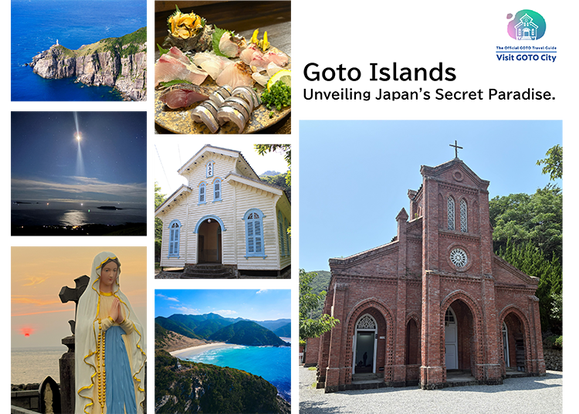
Walk in the Footsteps of Believers: A 4-Day Pilgrimage Across Goto Islands, Nagasaki Prefecture
by: Yohei Kato
Inspiration for Accommodations
-

Enjoy Mt. Fuji from the Comfort of Your Room! Recommended Ryokan with Mt. Fuji View
-

Stay Near the Cherry Blossoms! Hotels for Cherry Blossom Viewing in Tokyo
-

Family-Friendly Hotels with Free Shuttle to Disneyland: Convenient Access for a Magical Stay
-

Top Ranked Hakone Hotels with Mt. Fuji View: Enjoy Stunning Scenery from Your Private Space
-

Convenient Tokyo Hotels with Airport Shuttle: Ideal for Families and Heavy Luggage
-

Stunning Tokyo Tower View Hotels: Enjoy Spectacular Scenery from Your Private Space
-

Convenient Asakusa Hotels with Kitchens: Ideal for Extended Family Visits
-

Experience Luxury: Hakone's 10 Best Five-Star Accommodations
-

Enjoy Mt. Fuji Autumn Leaves! Top Hotels Near the Popular Autumn Leaves Corridor
-

Experience Hakone Fall Foliage from Your Room with Stunning Views
-

16 Secrets About Mt. Fuji, the Symbol of Japan: Even Japanese People Don’t Know That?!
-

Tokyo Train Map: Your Essential Guide to Subways and Railways
-
Ad

Spring in Taito: Home to Ueno & Asakusa! Step off the beaten path and curate your perfect 1-day itinerary
-
Ad

Japan Has New, Easy Mobile Charging Stations?! We Give New ChargeSPOT a Go!
-

Tokyo Station Top 10 Sweets Ranking!
-

15 Mistakes Tourists Make When Visiting Tokyo for the First Time
- #best ramen tokyo
- #what to buy in ameyoko
- #what to bring to japan
- #new years in tokyo
- #best izakaya shinjuku
- #things to do tokyo
- #japanese nail trends
- #what to do in odaiba
- #onsen tattoo friendly tokyo
- #daiso
- #best sushi ginza
- #japanese convenience store snacks
- #best yakiniku shibuya
- #japanese fashion culture
- #best japanese soft drinks





















